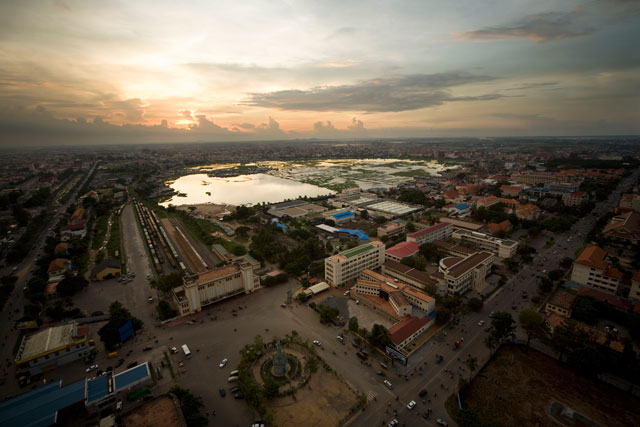Will Phnom Penh miss its last chance to forge a leafy future?
WITH its carpet of water-logged morning glory and panoramic sunsets, visitors and locals once treasured Boeung Kak lake as a rural oasis amidst the traffic-choked streets of central Phnom Penh. Two years after construction began on a controversial development, the lake has become a giant sand-bank, awaiting the erection of a bland commercial and housing development. Little now remains of the flourishing community that once ringed its shores.
As well as coming at great human cost – rights groups say more than 4,000 families are set to be displaced in legally dubious circumstances – some say the Boeung Kak development also represents a great lost opportunity for the city, ceding one of its last remaining green spaces to colourless suburban sprawl.
“Well-designed green, open space with an urban context is a no-brainer,” said Hallam Goad, an advisor at local housing rights group Sahmakum Teang Tnaut. He cited New York’s Central Park, developed in 1858 on an 843-hectare site, as a key example of the importance of green spaces. It was also something well recognised as far back as the Babylonian, Egyptian and Chinese civilisations. “In all of these situations the value – cultural, spatial and financial – was abundantly clear,” Goad said.

Photo: Courtesy of Nicolas Axelrod. Please visit his website at www.nicolasaxelrod.com.
Things have not always been so grim at the lakeside. In late 2003, Phnom Penh municipality, with assistance from the French government, organised an international design competition for the Boeung Kak area and invited teams to submit plans for the site. The winning design – known as the ‘Pearl Plan’ – was announced by Governor Kep Chuktema in April 2004, winning praise from the competition organisers for creating “a dense urban green lung in an Asian metropolis, which will reclaim for Phnom Penh the title of ‘The Pearl of Asia.'” The plan featured a “vast green space accessible to all”, and a dense residential area, located to the north of the lake, which would be open to “all categories of population”.
In mid-2006, however, the municipality quietly shelved the Pearl Plan, announcing it would fill all but 10% of the lake. Early in 2007, it signed a lease agreement with obscure local developer Shukaku Inc, a company owned by Cambodian People’s Party Senator Lao Meng Khin, granting it 99-year development rights over the lakeside – all for a paltry $79m.
Song Bonna, the head of Bonna Realty, said that if put on the market now, the land within the project area would fetch “plus or minus $1,000” per square metre, a figure that could double once the development is completed in a few years. Those values, spread over the 133 hectares of the project site, yield a total land value of between $1.3 and $2.6 billion – or up to 32 times the cost of the lease.
It’s unclear what Shukaku plans to build at the lake, though City Hall has stated that it will include housing, luxury apartments, office buildings, shopping precincts, banks, hotels and entertainment venues.
Goad said Boeung Kak – “a prime, gilt-edged site in the centre of the city” – was Phnom Penh’s last opportunity to create a lasting legacy for future generations. A well-designed development at the lakeside, chosen through a global competition, could give the city “a green lung” and ample space for public recreation and cultural events – something that could bring “delight, progress, kudos and investment”.
“The alternative is a site which is sold off piecemeal, developed as shop houses and low-end shopping malls, adding 50,000 residents to the area and compounding already dire traffic congestion,” he said.
Song Bonna said that retaining the lake and pursuing a development “with green, with clean water” would only boost the value of the remaining land. “Of course, if the development was to become a high-end development, with a big, beautiful lake it will be much more valuable,” he said.
Aside from missed opportunities, the project could also have wider implications for the city. According to a 2009 report by a team of Australian engineers, the filling of the lake for the project will eliminate a major rain catchment, leading to ‘significant impacts on property’ in areas adjacent to the lake. ‘While the lake is a closed system with little catchment contribution beyond the lake itself, the proposed development area is large enough to generate large volumes of run-off,’ stated the report, which involved hydraulic modelling of the Boeung Kak area.
The engineers found that the main areas affected would be ‘immediately to the north of the Boeung Kak area on both the east and west sides of the railway embankment, and approximately 1.5 kilometres to the north’. The effects of the lake’s reclamation have arguably already been seen in parts of northern Phnom Penh, including Russei Keo district, which has spent much of the past two wet seasons under a foot of water.
After the developer started filling the lake in August 2008, Helen Grant Ross, an urban architect and co-author of Building Cambodia: New Khmer Architecture, 1953-1970, said the city was “an extremely fragile” site, and that Shukaku was underestimating the unpredictability of the urban environment, especially where floods were concerned.
“The water level of the Mekong varies enormously from one year to another,” she said. “One day… ‘the Dragon’ will take its revenge and flood the whole area.”
[Published in Southeast Asia Globe magazine, June 2011]



